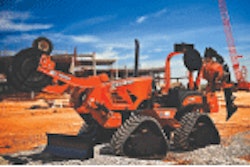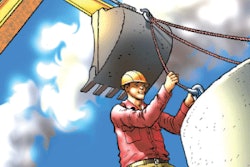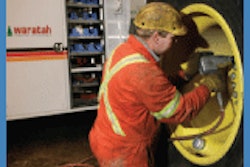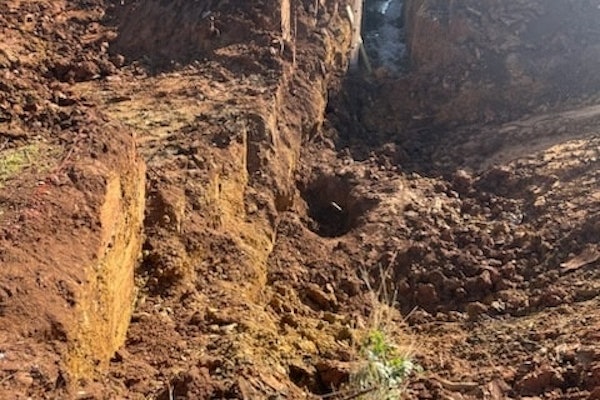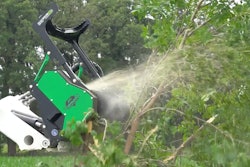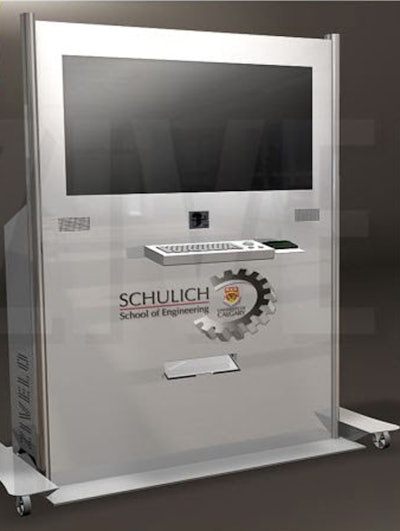 Mobile i-Booth
Mobile i-BoothPart of the mission of construction equipment upgrades and new releases of construction technology is decreasing the chances of operator error. Because, as guys on the jobsite know, as operator error is decreased, efficiency and productivity increase.
But a research team from the University of Calgary recently discovered that operator error can also occur before the work even begins. They found that morning toolbox meetings “lacked effectiveness and enthusiasm” and that by and large, the supervisors heading up these meetings were not delivering the day’s work agenda in the most understandable way.
Headed up by civil engineering professor and Canada research chair of project management systems Janaka Ruwanpura, the University of Calgary team has spent the last five or six years developing a solution: the i-Booth kiosk.
“This is the future of construciton for navigating information,” Ruwanpura recently told Equipment World. “[Team members on the jobsite] are desperate for more information. We have found that they waste a lot of time searching for information, drawings and details because they don’t have access to that information right away.”
“With i-Booth, you can look for that information and you can make decisions very quickly. It’s all connected to each other.”
Short for “Information Booth,” the i-Booth kiosk, now in its second generation of design, comes in two variants, both of which are dominated by a 42-inch touchscreen display. The first is a wall-mounted unit with a body a little thicker than the first flat-screen TVs. The second is the mobile i-Booth, a stand-up unit on wheels for moving about the jobsite. Ruwanpura said the research team is aiming to commerically release the i-Booth kiosk in the fall of this year.
But as Lahiru Silva, the Ph.D. candidate and team member who designed the i-Booth said, the hardware would be nothing without the proper software. The research team behind the i-Booth found that general contractors lose between 180 and 200 minutes per supervisory team member per day in what it calls “ineffective information management subsystems.” To fix that, the team designed a software framework specifically for contractors and team members to minimize time wasted looking for, sharing and then acting upon information on a jobsite.
The kiosks can be connected to the Internet via a wired Ethernet connection or wirelessly via Wi-Fi or a GSM wireless data air card. Team members will be able to view PDFs, DWFs (design web format files) and Building Information Management files on the kiosk. They will also be able to view, update and share design and shop drawings, safety and quality specifications, BIM files, weather forecasts and receive virtual supervision through the kiosk.
Though work on the i-Booth began before the iPhone, iPad, and Android devices were even released, it will come to market and onto jobsites well after those devices have been adopted for much of the same functionality. However, Silva said the i-Booth hasn’t been developed as a competitor to those tools. Rather, the kiosk integrates with those smartphones and tablets and brings their functionality to a larger screen when needed.
“With devices like iPads and all the other tablet computers and smartphones, the main problem is that the area you are wokring with is so small,” Silva said. “There are people already utilizing smartphones and iPads so what we want to give them is an addition. For instance, one of the things they use iPads for is viewing BIM and models. If it is a simple model they can navigate through the model without any problem on the iPad. But if it is a complex model it can be really difficult to navigate with an iPad because of the smaller screen.”
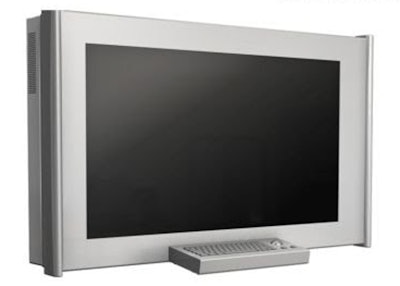 Wall-mounted i-Booth
Wall-mounted i-BoothSilva added that the iPad and Android tablets are not designed with the “rugged, harsh environment” of a construction site in mind. The i-Booth on the other hand “was designed specifically for construction,” he said. He noted that the i-Booth will also be able to connect to laptops and other peripherals needed on the jobsite.
Since 2009, the i-Booth has been trialed on 10 to 15 construction jobsites, Ruwanpura said, adding that many of those contractors have told the research team they want one permenantly. These trials, including tests done in 2011 at SAIT Polytechnic Trade and Technology Complex with PCL Management Inc., found that the kiosk provided jobsites with a more than 70 percent jump in worker satisfaction, a 10 percent increase in tool time, and 17 percent increase in overall productivity.
Silva said those trials resulted in team members utilizing the kiosk thorughout the day. “It has also served as a communication portal,” Silva said. “Team members have used the kiosk to get info and send updates to their home office. “
Looking forward, Silva said he believes technology like the i-Booth will continue to expand on construction jobsites as more and more workers become comfortable with touch-based, mobile technology. However, for these products to be successful, Silva stressed the importance of first tailoring the hardware to the jobsite and then designing the software in the same manner.
“Because of the iPad and other touchscreen devices a lot of people are now more comfortable with the touch functionality than with a keyboard and the mouse,” Silva said. “But the software must be designed to work hand-in-hand with the hardware. It must be easy to navigate with a pretty obvious UI.”




